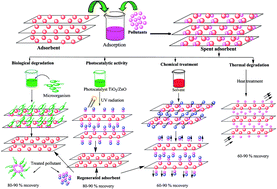Regeneration performance of clay-based adsorbents for the removal of industrial dyes: a review
Abstract
The present review covers the regeneration capacity and adsorption efficiency of different adsorbents for the treatment of industrial dyes to control water pollution. Various techniques and materials have been employed to remove organic pollutants from water; however, adsorption techniques using cost-effective, ecofriendly, clay-supported adsorbents are widely used owing to their simplicity and good efficiency. Among all the natural adsorbents, activated carbon has been found to be the most effective for dye adsorption; however, its use is restricted due to its high regeneration cost. Clays and modified clay-based adsorbents are the most efficient clarifying agents for organic pollutants as compared to activated carbon, organic/inorganic, and composite materials. Regeneration is an important aspect to stimulate the adsorption efficiency of the exhausted/spent adsorbent for water treatment. A number of techniques, including chemical treatment, supercritical extraction, thermal, and photocatalytic and biological degradation, have been developed to regenerate spent or dye-adsorbed clays. This review discusses how these techniques enhance the adsorption and retention potential of spent low-cost adsorbents and reflects on the future perspectives for their use in wastewater treatment.

- This article is part of the themed collections: Adsorption and degradation of pollutants and Editors' collection: Environmental chemistry: Pollution control


 Please wait while we load your content...
Please wait while we load your content...